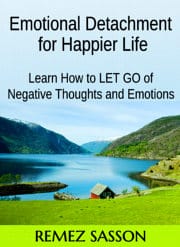
Advaita Vedanta, one of the most profound schools of Indian philosophy, translates to “non-dualism,” emphasizing the oneness of reality.
Rooted in the teachings of ancient texts like the Upanishads, it asserts that the ultimate truth (Brahman) is the only reality, while the perception of separateness in the world is an illusion (Maya).
From this perspective, mental and emotional detachment becomes not just a tool for spiritual growth but a direct path to experiencing this ultimate truth.
Browse our online courses on meditation, positive thinking, overcoming procrastination, and freedom from distractions.
Detachment, or vairagya, is seen as a critical practice that allows seekers to transcend the dualistic experience of attachment and aversion, joy and sorrow, pleasure and pain.
In modern times, many spiritual teachers and gurus have expanded on this philosophy, making it accessible to people living in the world’s complexities.
They provide advice on how to live a detached life while fully engaging with the world around us.
This article will explore mental and emotional detachment through the lens of Advaita Vedanta and non-duality, drawing from the wisdom of renowned teachers and providing practical advice on how to integrate these teachings into everyday life.
The Philosophy of Advaita Vedanta and Non-Duality
At the core of Advaita Vedanta lies the principle that everything in existence is an expression of a single, unchanging reality-Brahman.
The apparent diversity and multiplicity we perceive are illusory, a result of our limited minds imposing distinctions on what is fundamentally one.
From this viewpoint, the individual self, or jiva, is not separate from the universal self, Atman. However, due to ignorance (avidya), we perceive ourselves as distinct entities bound by the notions of time, space, and causality.
Mental and emotional detachment, in the context of Advaita, is about transcending the false identification with the ego and the external world. It is the process of recognizing that our thoughts, emotions, and experiences are transient and ultimately unreal when compared to the eternal nature of the Self.
When we realize that the source of our identity is the infinite Brahman, we can begin to detach from the fleeting and often distressing experiences of life, knowing that they do not define our true nature.
Non-duality takes this idea further by positing that there is no division between the individual and the universe. Everything is interconnected, and separateness is an illusion. Therefore, mental and emotional detachment is not about withdrawing from life or becoming indifferent to others. Rather, it is about seeing beyond the surface level of reality and recognizing the oneness that underlies all existence.
Mental and Emotional Detachment in Advaita Vedanta
Detachment (vairagya) is considered essential for spiritual seekers in Advaita Vedanta. It refers to a state of being where an individual is no longer emotionally or mentally entangled in the outcomes of worldly actions.
This doesn’t imply a rejection of life but rather a shift in perspective that allows one to engage with the world without being bound by it.
1. Detachment from the Mind
From the perspective of Advaita Vedanta, the mind is a tool that can either be a source of bondage or liberation. When we are caught in our thoughts, emotions, and desires, we are bound to the cycle of pleasure and pain, success and failure.
However, we can become observers of the mind rather than its victims by developing mental detachment.
The great teacher Ramana Maharshi, a renowned exponent of Advaita, emphasized the practice of self-inquiry (atma vichara) to help seekers detach from their mental processes.
By constantly questioning “Who am I?” and turning attention inward, one begins to see that thoughts and emotions are not the essence of the self but mere temporary phenomena.
This practice creates a sense of distance from the mind, allowing one to witness mental activities without becoming entangled in them.
Related: Nonduality quotes.
2. Emotional Detachment
In the Advaitic sense, emotional detachment is not about becoming cold or indifferent. It involves understanding that emotions are transient experiences that arise and dissolve within consciousness.
By identifying with the deeper, unchanging self (Atman), one can remain unaffected by the emotional highs and lows that accompany worldly existence.
Nisargadatta Maharaj, another prominent non-dual teacher, often spoke about how emotional suffering arises from misidentification with the body and mind.
He encouraged seekers to see themselves as pure awareness, witnessing emotions without attachment. This realization helps one navigate life’s emotional turbulence without being overwhelmed by it.
Practical Steps for Mental and Emotional Detachment
While the philosophy of non-duality can seem abstract, there are practical methods that spiritual teachers have offered to cultivate detachment. These methods can be integrated into daily life and can help anyone striving for inner peace and self-realization.
1. Mindfulness and Meditation
One of the most direct ways to cultivate mental and emotional detachment is through mindfulness and meditation. Mindfulness allows one to observe thoughts and emotions as they arise, without judgment or attachment.
Mindfulness meditation helps create space between the self and the mental or emotional experience, making it easier to maintain a state of detachment.
In meditation, particularly in Advaita Vedanta practices like self-inquiry, one focuses on the true self and moves beyond the identification with thoughts and feelings. Over time, this practice reveals the illusory nature of the mind and emotions, and a natural detachment begins to form.
2. Practice Non-Reaction
Another method for cultivating detachment is to practice non-reaction to situations. This means developing the ability to observe circumstances without immediately reacting based on emotions or ingrained patterns.
By pausing before reacting, you give yourself the space to act from a place of awareness rather than emotional reactivity.
This advice echoes the teachings of Jiddu Krishnamurti, who often spoke about the importance of being aware of one’s reactions without becoming entangled in them.
By observing thoughts and emotions in real time, one can detach from the habitual responses that often lead to suffering.
3. Self-Inquiry and Reflection
Engaging in regular self-inquiry and reflection helps deepen the understanding that the true self is not the mind or the emotions but pure awareness. Asking questions like “Who is feeling this emotion?” or “Who is thinking this thought?” leads to a deeper recognition of the self as the witness of all experiences.
Sri Ramakrishna and his disciple Swami Vivekananda encouraged self-reflection as a way to detach from the ego and align with the higher self.
By consistently reflecting on the impermanent nature of emotions and mental states, one can cultivate a sense of detachment from them.
4. Service and Surrender
Detachment can also be cultivated through selfless service (karma yoga) and surrender (bhakti yoga). In karma yoga, one performs actions without attachment to the results, thus practicing detachment from both success and failure.
Similarly, surrender to a higher power, as taught in bhakti yoga, involves relinquishing the ego’s control and trusting in the divine will. These practices help dissolve the personal ego, which is the root of mental and emotional attachment.
Insights from Modern Gurus
Several modern teachers have expanded on Advaita Vedanta’s teachings on detachment, making them more accessible to contemporary seekers.
For instance, Mooji, a Jamaican-born spiritual teacher who follows the Advaita tradition, often reminds his students to remain as the observer of thoughts and emotions. He encourages people to rest in their true nature as pure awareness rather than identifying with passing thoughts and feelings.
Eckhart Tolle, though not strictly an Advaitin, echoes similar themes in his teachings on presence and detachment from the mind. His book The Power of Now emphasizes the importance of disidentifying from the mind and emotions to live in a state of peace and presence.
Detachment Is the Gateway to Greater Freedom and Clarity
Mental and emotional detachment, from the Advaita Vedanta and non-duality perspective, is not about withdrawing from life but about shifting the perspective through which we engage with life.
By recognizing the illusory nature of the world and the mind, we can begin to cultivate a state of detachment, allowing us to experience life more fully without being overwhelmed by it.
Through practices such as mindfulness, meditation, self-inquiry, non-reaction, and the guidance of spiritual teachers, we can slowly detach from the mental and emotional disturbances that so often cloud our experience of reality.
In this way, detachment becomes not a means of escape but a gateway to living with greater freedom, clarity, and connection to the ultimate truth of non-duality.
Browse our online courses on meditation, positive thinking, overcoming procrastination, motivation, and freedom from distractions.



